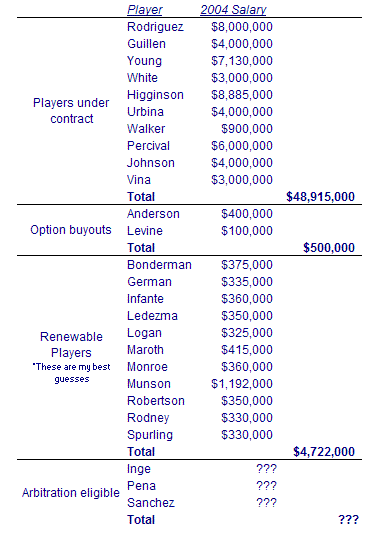It looks like the Tigers best chances to land a big free agent bat are:
1. Offer Beltran the 10 year, $200 million that Boras is asking for
or
2. Take a shot at an injured Magglio Ordonez
As much as I’d like to get Beltran, the Tigers won’t be handing out any 10 year deals. As a result, Ordonez is a much more realistic option. The only reason Ordonez doesn’t have a 5 year $60 million dollar contract in hand already is due to concerns about his knees. Last year Ordonez had to undergo knee surgery. Unfortunately a complication called bone marrow edema required a second surgery. His health so far is unknown because agent Scott Boras cancelled a scheduled workout during the winter meetings, which isn’t a good sign.
If the Tigers can work out a creative contract, Ordonez is a risk worth taking. Ordonez’s career numbers are 307/364/525 and he has remained healthy thoughout his career until last year. From 1998-2003 he played in more than 145 games each year. As an outfielder, he is an average fielder.
Ordonez will be 31 next year so some dropoff over the next few years is possible, but he’d still be an upgrade if healthy. Another concern with Ordonez’s production is that he has played in hitter friendly US Cellular field. While he does hit better at home with an OPS of 978, he is still a pretty good hitter on the road with an 895 OPS over the last 3 years.
Because Ordonez was never really known as a speed player, even if he’s slower than before, it isn’t taking away a significant portion of his game. As long as the bat and batting eye are still there, Ordonez will be a valuable player.
The drawbacks are that corner outfield isn’t a pressing need for the Tigers. While a healthy Ordonez would be a clear upgrade over White/Higginson/Monroe the Tigers can get by with what they’ve got. Plus the fact that Higginson’s contract can’t be moved would mean the Tigers would be paying a ton for the right field position. It won’t solve the problems in centerfield, third base, ,or back up catcher.
All that being said, Ordonez is the Tigers best shot at improving their lineup. Other teams are staying away, and if the Tigers are the only bidder willing to offer multiple years that will give them some leverage. The trick is managing the health risk.
Ordonez’s knees can’t be insured. What the Tigers need to do is structure a deal similar to Pudge’s. There was no way that the Tigers would be able to fully insure Rodriguez’s 4 year contract. John Westhoff got creative and had an out for the Tigers if Rodriguez’s back problem flared up. Now I don’t know for sure, but it probably became possible for the Tigers to then insure the rest of Rodriguez. If the Tigers could negotiate a similar out for Magglio’s knees, that reduces the risk and may make the contract insurable. Another tactic could be to offer a one year contract where a second year vests based on games played.
With some creativity to mitigate the risk, Ordonez is worth taking a shot at.
Non baseball stuff
I received season 4 of the Simpsons for Christmas and I’m just amazed at how many of my favorite episodes are in 4. The Monorail, Mr. Plow, Homer skipping church, Whacking Day, the one where Homer gets busted for DOA (or DUI, I always get those mixed up). That’s about as good as it gets.
